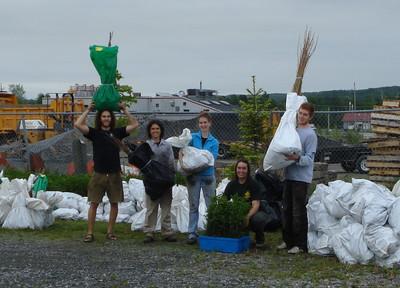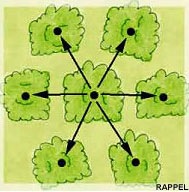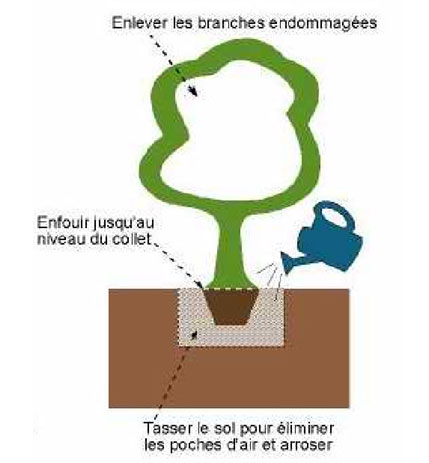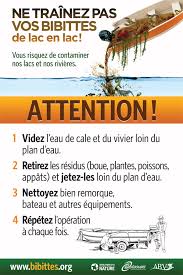Restoring Stream Banks and Shorelines
Context
Memphremagog's shoreline and stream edges are tremendously important in protecting the quality of the ecosystem– from eutrophication, cyanobacteria blooms and swimmer's itch. Over the years, the lake's shores and water sources have suffered disquieting changes from their natural characteristics. Residents have introduced an urban environment into the country: large lawns, few trees and manicured landscaping. Deforestation and artificial landscaping are not only damaging when practised in urban areas, they are more so along shore margins. When these natural margins are removed, erosion allows more sediment andphosphorus to enter the lake and permits excessive warming of the lake shore. This is why naturalization of the shore margins of the lake and its sources is critical.
Restoration is a major undertaking that will require effort on the part of all lakeside residents. Fortunately, this effort is not magical nor expensive. In addition, assistance is available for financing and consultation. We just need to roll up our sleeves and start work.
What is Restoration?
Restoration returns the shoreline margin from a degraded or artificial condition to its natural state as a buffer zone, so that this area can continue its normal filtration and protective functions and the lake can regain its natural cachet. By abandoning lawn and artificial landscaping and then reintroducing native shrubs, trees and herbaceous plants along shore margins, the objectives of protecting the shoreline and maintaining the aquatic ecosystems and potable water can be advanced.
Where can I purchase the plants ?
Different garden centres offer plants that suit the shoreline. In addition, several municipalities in the Memphremagog watershed offer free shrubs for naturalizing the shore. The distribution of these plants usually occurs in the early summer. Contact your municipality and organizations like COGESAF and RAPPEL to learn more.

Passive Method
The simplest way to restore is to let the natural vegetation grow. We can stop mowing and let nature take its course. The shore can then regenerate by itself. However, it could take more than 7 years to effectively protect the lake's edge and streams from the sun. Also the aesthetic aspect will be uncontrolled. In this case, if one wants to keep a view of the lake, it is still possible to prune a “green window” opening through the shore buffer zone. Note that there are now rules in some municipalities concerning pruning, requiring permission from the municipal inspector.
Greenscape Planting
To accelerate restoration of the shore, while controlling its appearance, one can choose to select and plant appropriate species. This selection is important because several factors help to ensure success. Before undertaking any planting of the shore margin, one must obtain a certificate of authorization from your municipal inspector. To obtain a certificate, you must submit a a landscape plan for approval.
Restoration by professionals
Several businesses in the region specialize in the restoration and stabilization of shore margins and banks. Through their competence in horticulture, they can help you plan the shore margin restoration according to your needs and budget. As well, these landscape businesses could carry out the landscaping needed.
When to restore?
The two ideal periods to do this work are early spring after high water until mid-June, or in autumn from the end of August. Periods of hot weather should be avoided and that is why it is best to plant early in the morning or late in the day, to avoid drying the plant roots.
What to plant?
Plant selection should focus on indigenous species that are well adapted to the local conditions, especially those that are growing nearby. Advice from experts in shore restoration could be useful, although much of this information can be obtained in guides and popular references. One can try to reproduce the local vegetation that can be found around the water margin. It is most important to ensure a good diversity of species that can play different roles in protection and cleansing: Trees and shrubs create shade, while their roots will soundly stabilize banks. Herbaceous plants will slow the flow of surface water, remove nutrients and retain surface sediment. The following lists will help you discover the right plants while at the same time provide you a display of great beauty.
- FIHOQ, 2008. Index of recommended Quebec plants for shoreline buffer zones. In French with English and Latin names.
- RAPPEL, 2008. Detailed list of ferns and grasses recommended for naturalization of shorelines. In French with Latin Names.
- RAPPEL, 2008. Detailed list of perennial plants recommended for naturalization of shorelines. In French with Latin names.
What conditions should I observe before planning my landscaping?
The choice of species will depend on the particular conditions of the surroundings, especially sun exposure, humidity, slope and type of soil.
Climate zone
Climate zone is determined as a function of the region's average, maximum and minimum temperatures
as well as the type and abundance of precipitation received.
Stability of the water edge
First you should confirm that the selected site is not eroding. If this is the case, consult a specialist in the techniques of stabilization by plant-engineering.
- Foundation of Lakes and Rivers of Canada, 2006. Techniques of Shoreline Stabilization.
Humidity and type of soil
It is important to correctly identify the type of soil of the sections to be restored. Knowing the nature of the shoreline's soil allows you to choose the plants that are best adapted to your landscape plan. You need to make the distinction between a wet, semi-dry and dry environment, so that you can make the appropriate choice of plants, to increase your chance of planting success.
- MDDEP, 2008. High-water line explanatory note.
Drainage
Surface slope and soil particle mix affects how quickly water will run-off or soak quickly into the ground. Observe areas where the ground is saturated with water and where it is drier.
Sun and Shade
How much sun exposure and shade do the areas receive? Observe which areas are most exposed to sun and which are more shaded.
What is a typical design of shoreline planting?
Depending on the obstacles to planting, shrub are ideally offset in alternate rows, that is, the plants of the top row are offset from the next lower row. Also, provide a nominal distance of one metre between shrubs and four to five metres between trees as shown below.

Some tricks to ensure planting success
As soon as you receive plants, ensure that the roots stay humid and that they are kept in a cool shady area, protected from the sun and wind until they are placed in the ground. Plants can dry out in a matter of minutes! For the planting itself, make a hole sufficiently deep to allow the roots to be spread out and so that the finished ground does not exceed the crown of the plant. Also ensure that the soil is well watered and tamped so as not to leave air pockets in the soil.
It is also a good idea to install tutors to support trees taller than one metre and to use protectors against deer , beavers and rodents.

Source : ZIP ALMA-JONQUIÈRE, 2008.
Remove dead branches. Cover up to the crown. Compact the soil to eliminate air pockets, and water thoroughly.
It is easy to keep a view to the water by piercing a simple “green” window. For relatively flat property, take care to trim, starting from the bottom, the tree branches that block the view, while maintaining a good cover of shrubs and plants. For sloping land, one can cut an opening in the top, or trim the trees at the height that will permit a view. The green window should not be a showcase window – the opening should not exceed two metres in width. Check with your municipal inspector for any relevant regulations.
How can I maintain access to the lake or river, through the shore margin?
A path or staircase can be maintained to provide access to the water through the shore buffer. Paths should be laid on a diagonal with respect to the shoreline, to avoid surface runoff into the lake.
How to maintain the shore margin?
After renaturalization, maintenance of the shore margin should be limited to a strict minimum. During the first summer, generously water the plants in the morning, especially during long dry periods. Clear the new plantings of vegetation that may choke them. Otherwise the shore margin does not need further intervention. Never use fertilizers or herbicides in the band of natural vegetation.
Where to start?
First of all, consult the municipality to ensure that the new landscape plan will respect the most recent regulations. It would be helpful to consult the guides and popular naturalization references as well. Here are several sources that could assist you.
To learn more
- MDDELCC : Lakes and watercourses : ours to save.

